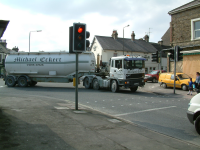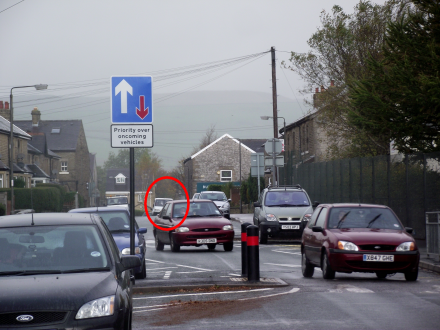Reading the road - The speed and position of other road users
As with many other things on this course, it may seem fairly obvious that you should look out for other road users, but remember, you are not just looking for them, you are looking for clues. What will they do next?
It's by paying intelligent attention to others that we can avoid accidents that should have been obvious!
Example:
The sign on the right shows priority over approaching vehicles, but will the driver of the white van (in the red circle) understand or obey the sign at his side of this traffic calming situation?
The Highway Code explains that those pedestrians most at risk on the road are over 60 and under 15.
Pedestrians:
Old people do not judge speed and distance very well and their reactions can be slow. Have they seen you? Can they hear you? Look for clues. Are they carrying white sticks? Are they looking your way?
 Knowledge of the Highway Code is fairly essential – for example, if we take blind people: how might you react differently if you saw a blind person with reflective red bands around his/her white stick as opposed to a plain white stick? (Good for pub quizzes as well!)
Knowledge of the Highway Code is fairly essential – for example, if we take blind people: how might you react differently if you saw a blind person with reflective red bands around his/her white stick as opposed to a plain white stick? (Good for pub quizzes as well!)
Children have little time to consider road safety; they are more interested in the game that they are playing, or the ice cream van that they are running after. Look for clues. Are they alone?
If one child runs or cycles into the road there will often be at least one more following; footballs are followed by children; cycles, seemingly abandoned at the side of the road, will mean that children are not far away.
All pedestrians, not just the young and old, are at risk on the road. If there are pedestrians about, make sure that you know what they are going to do before they do it.
Cyclists:
 A high court judge once ruled that a cyclist is entitled to wobble.
A high court judge once ruled that a cyclist is entitled to wobble.
Drivers should have more control over their vehicles than cyclists who are dependent upon physical strength and effort to pilot their machines.
Always leave plenty of room when passing cyclists, look out for clues about their next move. For example, a cyclist who looks around over his/her right shoulder may be about to turn right; a puddle in the road will cause a cyclist to move out.
Drivers:
If you are unsure about what other drivers are going to do next, leave plenty of space between your vehicle and their's.
The vehicle type may give you a clue about what to expect next.
 Large vehicles may have to take up unusual road positions in order to carry out manoeuvres.
Large vehicles may have to take up unusual road positions in order to carry out manoeuvres.
A sporty looking 'custom-car' may be driven by someone more interested in 'posing' than driving.
Look out for the actions of drivers:
A driver who has just stopped may open his/her door without checking to see if it is safe; a driver who seems to be dithering about may be a stranger to the area and could, therefore, make a last minute turn without a signal when he/she sees the road that he/she is looking for.
Next: Step 2 - Reading the road - All weather driving...
